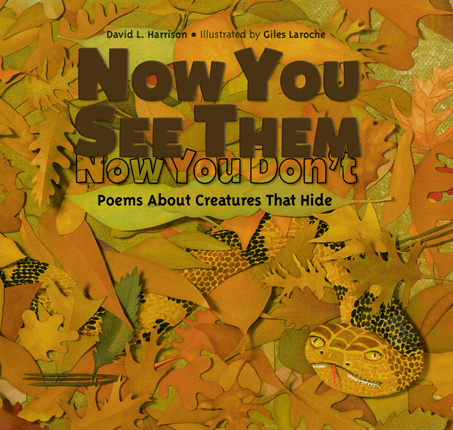| Now you see them, now you don't : poems about creatures that hide Author: Harrison, David L. | ||
| Price: $6.50 | ||
Summary:
A collection of clever poems introduces animals that use camouflage in order to find (or avoid being) dinner.
| Illustrator: | Laroche, Giles |
| Reading Counts Information: Interest Level: 6-8 Reading Level: 4.70 Points: 8.0 Quiz: 37531 | ||
Reviews:
Kirkus Reviews (+) (12/01/15)
School Library Journal (02/01/16)
Booklist (04/01/16)
Full Text Reviews:
School Library Journal - 02/01/2016 Gr 1–3—In this attractive collection of poetry about camouflage in nature, 19 entries are grouped into five sections: "Sea Life," "Reptiles & Amphibians," "Mammals," "Insects & Spiders," and "Birds." Each selection focuses on one creature, highlighting its use of camouflage in the wild. The verse is brief but catchy, and Harrison's sound use of rhythm and rhyme results in offerings that are pleasant to read aloud. Each poem is accompanied by an illustration done in cut-paper relief on hand-painted papers. Reminiscent of Steve Jenkins's collages, they are lively and engaging. Back matter contains additional information about each creature, including its scientific name and a few suggestions for further reading. VERDICT An altogether appealing volume for young poetry aficionados and animal lovers alike.—Lauren Strohecker, McKinley Elementary School, Abington School District, PA - Copyright 2016 Publishers Weekly, Library Journal and/or School Library Journal used with permission.
Booklist - 04/01/2016 Nineteen varied poems, illustrated in cut-paper relief, describe examples of animal camouflage to young readers. Using instances from sea life, reptiles and amphibians, mammals, insects and spiders, and birds, Harrison’s succinct poems detail the techniques used by these creatures to avoid detection. In “Bumblebee Moth,” for example, “A moth that looks / like a bumblebee / is nature’s gimmick / to scare away / its enemies / and save the mimic.” Laroche’s colorful artwork is appealing both in its attractive design and scientific detail. His spreads clarify and sometimes extend the text, as in “Crab Spider,” about an arachnid, depicted on two differently-hued flowers, which changes colors to blend with its surroundings. Extensive back matter provides additional information about each species and offers suggestions for further reading. Helping to bridge the gap between science and literature, this joins the growing number of excellent nature poetry titles, such as Joyce Sidman’s Winter Bees and Other Poems of the Cold (2014) and Irene Latham’s When the Sun Shines on Antarctica and Other Poems about the Frozen Continent (2016). - Copyright 2016 Booklist.



